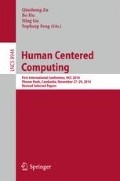Abstract
An user satisfaction evaluation model based on blink interval was proposed. This model can be used to calculate user satisfaction with blink interval during usability testing. 31 participants were recruited to fulfill 2 tasks and recorded their eye movement data during the website usability testing. The participants were also required to give their satisfaction scores after each task according to the web design. The results showed a strong correlation between the users’ blink interval and their satisfaction and the lower the satisfaction is, the longer the blink interval is. A mathematical model between satisfaction and blink interval was obtained and can be used to calculate satisfaction scores (1~5 points) on corresponding blink intervals. Designers could forecast user satisfaction curve in the usability testing via this model and improve product availability in the next design based on the results.
Access this chapter
Tax calculation will be finalised at checkout
Purchases are for personal use only
Preview
Unable to display preview. Download preview PDF.
References
Nielsen, J.: Usability Engineering. China Machine Press, Beijing (2004)
Nancarrow, C., Brace, I.: Saying the “right thing”: Coping with Social Desirability Bias in Marketing Research. Bristol Business School Teaching and Research Review 3(11) (2000)
Hazlett, R.: Measurement of user frustration: a biologic approach. In: CHI 2003 Extended Abstracts on Human factors in Computing Systems, pp. 734–735. ACM (2003)
Iqbal, S.T., Zheng, X.S., Bailey, B.P.: Task-evoked pupillary response to mental workload in human-computer interaction. CHI 2004 Extended Abstracts on Human Factors in Computing Systems, pp. 1477–1480. ACM (2004)
Zhu, Z., Wu, X., Wang, L., Qi, L.: Detection Method of Driver Fatigue Based on Blink Duration. Computing Engineering 34(5), 201–203, 206 (2008) (in Chinese).
Hou, W., Gao, X., Li, T.: Customer Satisfaction Evaluation Model Based on Pupil Size Changes. Space Medicine & Medical Engineering (CN11-2774/R) 26(5), 343–346(2013) (in Chinese)
Hankins, T.C., Wilson, G.F.: A Comparison of Heart Rate, Eye Activity, EEG and Subjective Measures of Pilot Mental Workload during Flight. Aviation, Space and Environmental Medicine 69(4), 360–367 (1998)
Jacob, R.J.K., Karn, K.S.: Eye tracking in human-computer interaction and usability research: Ready to deliver the promises. Mind. 2(3), 4 (2003)
Goldberg, Joseph H.: Xerxes P. Kotval.: Computer interface evaluation using eye movements: methods and constructs. International Journal of Industrial Ergonomics 24(6), 631–645 (1999)
Palmer, J.W.: Web Site Usability, Design and Performance Metrics. Information Systems Research 13(2), 151–167 (2002)
Muylle, Steve, Moenaert, Rudy: Marc Despontin.: The conceptualization and empirical validation of web site user satisfaction. Information & Management 41(5), 543–560 (2004)
Author information
Authors and Affiliations
Corresponding author
Editor information
Editors and Affiliations
Rights and permissions
Copyright information
© 2015 Springer International Publishing Switzerland
About this paper
Cite this paper
Hou, W., Yang, J., Lyu, F., Li, T. (2015). User Satisfaction Evaluation Model Based on Blink Interval. In: Zu, Q., Hu, B., Gu, N., Seng, S. (eds) Human Centered Computing. HCC 2014. Lecture Notes in Computer Science(), vol 8944. Springer, Cham. https://doi.org/10.1007/978-3-319-15554-8_39
Download citation
DOI: https://doi.org/10.1007/978-3-319-15554-8_39
Published:
Publisher Name: Springer, Cham
Print ISBN: 978-3-319-15553-1
Online ISBN: 978-3-319-15554-8
eBook Packages: Computer ScienceComputer Science (R0)

